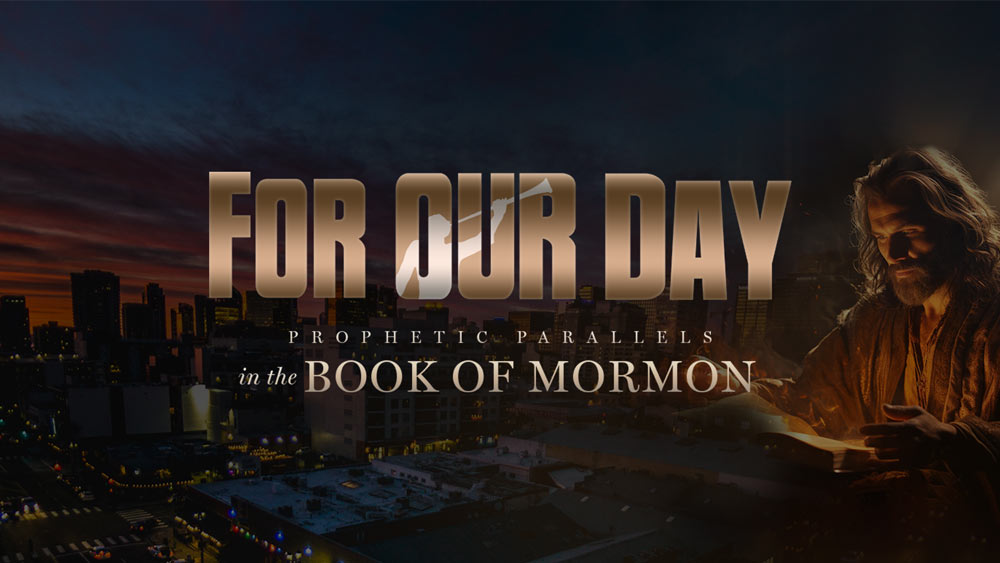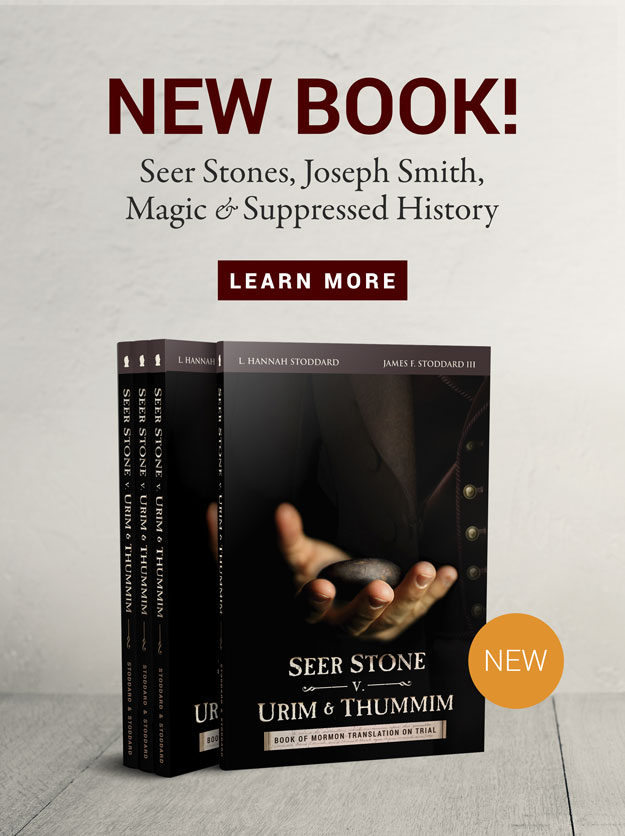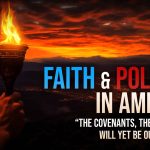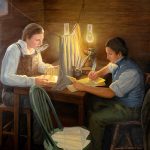Administration of President Taylor — 1880-1887

The Year of Jubilee
April 6, 1880, was just fifty years from the day of the organization of the Church. On this date and the three succeeding days, the fiftieth annual conference of the Church was held in the tabernacle, Salt Lake City. Preliminary meetings were also held on the 4th and 5th. All the members of the Council of the apostles were present, excepting George Q. Cannon, who was in Washington representing Utah as a delegate in Congress. President John Taylor drew attention to the fact that this was the jubilee year of the Church, and referred to the custom which prevailed in old Israel, as set forth in the twenty-fifth chapter of Leviticus. It was proposed that it be made a year of jubilee and forgiveness in the Church. The Church set the example by striking off one half the indebtedness held by the Perpetual Emigrating Fund Company, against individuals classed as worthy poor, amounting to the sum of $802,000. One thousand cows and five thousand sheep were also distributed among the needy. The Saints were advised to be charitable and liberal in their dealing with one another. The sum of $75,899, in unpaid tithing, one half the amount due, was remitted against the Saints who were unable to meet their obligation. It was proposed that the Relief Society lend to the farmers, who had suffered loss because of drouth the year before, 34,761 bushels of wheat which they had on hand. This was to be repaid by the farmers, without interest, at the close of the next harvest. “If you find people owing you who are distressed, if you will go to work and try to relieve them as much as you can, under the circumstances, God will relieve you when you get into difficulties,” said President Taylor. “I will tell you that,” he added, “in the name of the Lord. Let us act on a kind, generous, brotherly principle, doing good one to another and carrying out the principles of the everlasting Gospel in our lives.”1
The Pioneer Day Celebration
The spirit of the jubilee was carried through the year, and was again made manifest in a marked manner at the celebration—on pioneer day, July 24, 1880. There was a long pageant, which paraded through the streets of Salt Lake City, and on three of the floats were natives from twenty-five countries. representing the people who had been gathered through the preaching of the Gospel. A banner was also carried upon which the inscription was written: “I will gather you out from all nations.” Exercises were held in the tabernacle and patriotic speeches were made. Utah had a population at that time of 143,690, showing an increase of nearly 60,000 in the past decade. The great majority of these were members of the Church.2
President Taylor’s Prediction
At this celebration President Taylor gave- utterance to the following prediction: “There are events in the future, and not very far ahead, that will require all our faith, all our energy, all our confidence, all our trust in God, to enable us to withstand the influences that will be brought to bear against us. We cannot trust in our intelligence; we cannot trust in our wealth; we cannot trust to any surrounding circumstances with which we are enveloped; we must trust alone in the living God to guide us, to direct us, to lead us, to teach us and to instruct us. And there never was a time when we needed to be more humble and more prayerful; there never was a time when we needed more fidelity, self-denial, and adherence to the principles of truth, than we do this day.”3
Re-organization of the First Presidency
At the general semi-annual conference held in October, 1880, reports were made of the distribution of the cattle, sheep and other substance, which was voted on at the April conference. A time of great rejoicing was had and on the last day (10th) the First Presidency was again re-organized with John Taylor as President of the Church, and George Q. Cannon and Joseph F. Smith as his first and second counselor, respectively. Elders Francis M. Lyman and John Henry Smith were called to the apostleship, leaving one vacancy unfilled. The voting was done by quorums, as it was at the sustaining of President Young, beginning with the apostles; second, the patriarchs, presidents of stakes and counselors, and high councils; third the high priests; fourth the seventies; fifth, the elders; sixth, the bishops and their counselors; seventh the lesser priesthood—priests, teachers, deacons; eighth, the presidents of various quorums, and last the whole congregation.4
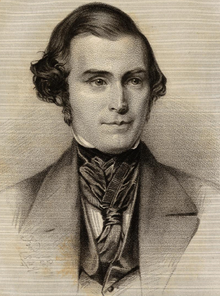
Death of Orson Pratt—Calling of Elders Teasdale and Grant
Orson Pratt, the last surviving members of the original council of apostles, died in Salt Lake City, October 3, 1881. Elder Pratt possessed a remarkable analytical mind and was one of the world’s great mathematicians. His discourses and writing on the Gospel are clear and convincing.
With all his learning he was humble and unassuming, having perfect assurance in the divinity of the mission of Joseph Smith. On October, 1882, Elders George Teasdale and Heber J. Grant were called to the apostleship by revelation given through President John Taylor. Elder Seymour B. Young was also called to be one of the seven presidents of the seventies. fn
This revelation was given October 13, 1882, and the brethren were ordained three days later.
The Lord, in this revelation, called upon the various quorums of the Priesthood to arise and purify themselves, and for the members to magnify their callings. The Saints were commanded to set their houses in order that they might be purged from sin. The prediction was made that eventually Zion should be established and the nations shall yet acknowledge the Lord.5

Dedication of the Logan Temple
The Logan Temple—the second structure of the kind built in Utah—was dedicated May 17, 1884, under the direction of President John Taylor, who offered the dedicatory prayer. The site for the temple was dedicated May 17, 1877, by Orson Pratt. The work of excavation was begun May 28, and the laying of rock in July following. September 19, 1877, the corner stones were laid, the order of temple-building being followed. The dedicatory services in 1884, which lasted three days, were very solemn and impressive, and the Saints rejoiced that another house of the Lord had been built, where work for the salvation of the living and the dead could be performed.6
Anti-“Mormon” Legislation Agitated
During the eighties there appeared to be a united effort on the part of the press and the denominational ministers to force legislation against the Latter-day Saints. The chief instigators of this campaign were anti-“Mormon” residents of Utah, with the aid of their organ, the Salt Lake Tribune. President Rutherford B. Hayes, who was imposed upon by this agitation, in a message to Congress in December, 1879, and again in 1880, referred to the “Mormon” question and plural marriage. President Garfield made similar reference in his inaugural address, and after the assassination of Garfield, President Arthur took the matter up in his first message to Congress.7
Bitterness of “Christian” Ministers
The bitterness of the times was expressed by the Chicago Interior, a Presbyterian paper, in the summer of 1881, as follows:
“Let the lands and tenements of the Mormons be thrown open to original entry by civilized settlers. Let it be understood that the army will keep out of the way in Utah for four years, and that the use and occupation of Mormon property for one year is to give a preemption title. There are enough young men in the West and South, who are seeking homes, to finish up the pest, fumigate the Territory, and to establish themselves in ninety days after the word ‘go’ is given.”
In consonance with this “Christian” spirit, the Rev. J. H. Peters at Dayton, in October, 1881, said to his congregation: “I would that the guns of Fort Douglas were turned upon them [the ‘Mormons’] and they made loyal by this means if by no other.” Falsehoods of the deepest hue were also uttered. The notorious T. DeWitt Talmage, for instance, circulated the false report that the assassin of President Garfield was a “Mormon,” and the Latter-day Saints were wickedly accused by this reverend, and others, of holding meetings and rejoicing because of the President’s death.8

The Edmunds Bill
The result of all this agitation was the passing of a law in March, 1882, by Congress, amending the law of 1862. It was known as the Edmunds Law, because it was introduced into the senate by George F. Edmunds of Vermont. This measure not only made punishable the contracting of plural marriage, but also polygamous living, which was designated as “unlawful cohabitation.” The punishment for contracting a plural marriage remained the same as in the law of 1862—a fine of five hundred dollars or imprisonment for five years, or both, in the discretion of the court.
The President of the United States was authorized to grant amnesty to those who had entered into plural marriage before the passage of this bill, under certain conditions and limitations, and their children born before January 1, 1883, were legitimated.
“No polygamist, bigamist, or any person cohabiting with more than one woman, and no woman cohabiting with any of the persons described as aforesaid shall be entitled to vote at any election hold any office or place of public trust, honor or emolument, in, under, or for any such Territory or place, or under the United States,” was declared in this bill. Of course this was not intended to apply to “Gentiles” who “cohabited” with more than one woman, outside of the marriage relation, and such—and Utah had them—were shielded by the officers of the law. Moreover, the mere belief in the doctrine of plural marriage was sufficient to bar a person from jury service.
All registration and election offices were declared vacant, and provision was made for a commission of five persons to be appointed by the President, and with the consent of the senate, to attend to the duty of registration of voters, canvassing the returns of elections for members of the territorial legislature, and issue certificates, or other evidence of election, until otherwise provided by law. They were to be paid three thousand dollars a year and to continue in office until the legislature, elected and qualified under the Edmunds Law, should provide for filling the offices as authorized by the statute.9
Self-Government Denied
By this law, local self-government was annihilated in Utah, contrary to all the guarantees granted to free people since the days of the framing of the government of the United States, if not since the days of King John. Following in the wake of this legislation there was conducted a crusade against the “Mormon” people without a parallel in the history of the United States.10
The Utah Commission
The five commissioners appointed through the Edmunds Law, arrived in Utah, August 18, 1882. They were: Alexander Ramsey, of Minnesota, chairman; Algernon S. Paddock, of Nebraska; George L. Godfrey, of Iowa; Ambrose B. Carlton, of Indiana; and James R. Pettigrew, of Arkansas, with Arthur L. Thomas, secretary. They immediately set to work on the duties assigned them, and appointed registrars for the November election, in a manner most unjust to the “Mormon” people. Eight of the registrars out of twenty-four, were members of the Church, yet the “Mormon” population was in excess of 120,000, and the “Gentile” population—including apostates and others classed as “doubtful”—was approximately 24,000. The commissioners also published rules to the guidance of the registrars and the government of election judges, which were manifestly unfair and beyond the scope of the law, which was done to disfranchise a large portion of the “Mormon” population.11
The Test Oath
Perhaps the most abominable and shameful thing they did was to prepare the following “test oath”:
Territory of Utah, County of…………….}ss.
I………., being first duly sworn (or affirmed), depose and say that I am over twenty-one years of age, and have resided in the Territory of Utah for six months, and in the precinct of…………one month immediately preceding the date hereof, and (if a male) am a native born or naturalized (as the case may be) citizen of the United States and a taxpayer in this Territory, or (if a female), I am native born, or naturalized, or the wife, widow or daughter (as the case may be) of a native born or naturalized citizen of the United States; and I do further solemnly swear (or affirm) that I am not a bigamist or a polygamist; that I am not a violator of the laws of the United States prohibiting bigamy or polygamy; that I do not live or cohabit with more than one woman in the marriage relation, nor does any relation exist between me and any woman which has been entered into or continued in violation of the said laws of the United States prohibiting bigamy or polygamy; and (if a woman) that I am not the wife of a polygamist, nor have I entered into any relation with any man in violation of the laws of the United States concerning polygamy or bigamy.
Subscribed and sworn before me this ……. day of 1882.
Registration Officer … .. Precinct.12
Careful Wording of the Oath
The expression “I do not live or cohabit with more than one woman IN THE MARRIAGE RELATION, was so placed as were other clauses to apply against the “Mormons” only. The “Mormon” press and preachers drew attention to this feature of the oath which denied to the “Mormon polygamist,” but permitted the “Gentile libertine,” the right to vote. The admission was commonly made that the Edmunds Law was prepared solely against the “Mormons” and did not apply to the immoralities of the “Gentiles.” This led the First Presidency in an address to the Saints in August, 1882, to say that they regretted that men of high positions would take that view of the law; but they perceived “with unmixed satisfaction” the sharp distinction the oath drew between marriage and licentiousness.13
The Law made Retroactive
Another infamous ruling was that any person who had lived in the plural marriage state, but was then not living in that relation, was denied the right of franchise; and this was interpreted to apply to those who had thus married even before the law of 1862. For instance, if a man had married two wives in 1850, before any law against plural marriage was enacted, and both wives had died before the law was passed; the commission ruled that he was a “polygamist” notwithstanding he had no wife living, and denied him the right to vote. “Once a polygamist always a polygamist,” was the common expression. Other rulings and actions, contrary to the law, but intended to annoy and disfranchise the members of the Church, that the minority might rule, were attempted, among them denial to the women of their suffrage.14
A Campaign of Persecution
From this time forth until the close of President John Taylor’s administration, and beyond, the government of the United States carried on a campaign of prosecution, that was relentless and even cruel, against all members of the Church who had married plural wives. Men were punished, not for contracting plural marriage since the passage of the law, but for “unlawful cohabitation;” federal officers hunted men and women and dragged them before selected grand juries, where they were shamefully insulted. Even small children did not escape, but were forced to testify and answer improper and indecent questions, with the object in view of obtaining evidence against their parents; and this was done with threats of dire punishment and contempt of court, if they refused. Such actions partook too much of the days of the Spanish Inquisition. Paid spies—men of debased character—were employed to gather evidence. Among those who sat on juries to judge the “morals” of the “Mormon” people, were those who were recreant to every law of decency. The petty officers and the judges of the courts carried on a reign of terror in their determination to stamp out the practice of plural marriage, and it appeared that the greatest crime in the world was for a man to acknowledge honestly that he was the husband of more than one wife, and that he diligently and faithfully supported them and their children; while for the libertine and the harlot there was protection by officers of the law.15
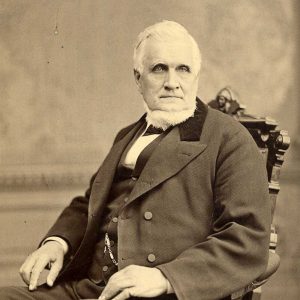
President Taylor’s Statement
At the general conference of the Church in April, 1882, President John Taylor spoke of the approaching storm. “While the excitement lasts,” said he, “it is useless to reason with the world; when it subsides we can talk to them.” He also expressed the views of the Latter-day Saints when he said: “We do not wish to place ourselves in a state of antagonism, nor act defiantly, toward this government. We will fulfil the letter, so far as practicable, of that unjust inhuman, oppressive, and unconstitutional law. But we cannot sacrifice every principle of human right. While we are God-fearing and law-abiding, and respect all honorable men and officers, we are no craven serfs, and have not learned to lick the feet of oppressors, nor to bow in base submission to unreasonable clamor. We will contend, inch by inch, legally and constitutionally, for our rights as American citizens.” So sore became the persecution that hundreds of homes were broken up and husbands and fathers were sent to the penitentiary for the offense of “unlawful cohabitation.”16
A Tribune Canard
To add to the evil of the times the circulation of false and malicious reports increased, and the Latter-day Saints were portrayed as the vilest of the vile. The result of this was continued persecution of the elders in the mission fields.
One of these abusive and lying canards appeared in the Salt Lake Tribune, March 16, 1884. It purported to be the disloyal utterances of “Bishop West, of Juab.” There was no Bishop West, and the falsehood was exposed. When the Tribune was caught red handed in its lying, it very reluctantly admitted the falsehood, but added that the report sounded like what was going on all the time. Articles of this kind were constantly appearing, and the members of the Church were repeatedly insulted and abused with the hope that some overt act might be committed through unendurable provocation, and thus occasion be made against the Church for its destruction. However, the persecuted people bore the insults without giving cause for such diabolical action.17
The Canard the Cause of Murder
The “Bishop West” hoax might have been forgotten if the falsehood had ended with the exposure of the Tribune story, but, unfortunately, it was circulated in Tennessee by a Reverend Vandevere, of Lewis County, who made it an occasion to attack the Saints in the South, and arouse the populace against them. He had been duly advised of the nature of the falsehood, but that made no difference; he continued to repeat the story. The result of this circulation of the Tribune’s falsehood, was the enacting of a tragedy, at Cane Creek, Lewis County, Tennessee, of a most shocking character.18

The Tennessee Massacre
It happened Sunday, August 10, 1884, That morning a number of elders and Saints met at the home of James Condor for religious worship. While the small congregation was assembling a mob of masked ruffians invaded the premises and shot and killed Elders John H. Gibbs, of Paradise, and William S. Berry, of Kanarra, and also two young men, Martin Condor and John Riley Hudson, who were not members of the Church, but who attempted to protect the elders. Young Hudson, securing his gun. shot and killed the leader of the mob, one David Hinson, but Hinson’s followers returned the fire, mortally wounding the young man who died about one hour later. Because of this retaliation the mob returned and poured a fire into the house through the windows, seriously wounding Mrs. Condor, and riddling the body of Elder Berry. They then secured the body of their leader and made off. Two other missionaries, Elders William H. Jones and Henry Thompson, escaped.19
Elder Roberts Secures the Bodies of the Slain
Elder B. H. Roberts was at Chattanooga, in charge of the mission in the absence of President John Morgan, who was in Salt Lake City. At the peril of his own life he went forth and secured the bodies of the missionaries and had them forwarded to Utah, where the “Mormon” people were in mourning. The bodies of the slain elders were interred at their home towns, but public funeral services were also held in Salt Lake City, August 24, 1884.20
Governor Murray to Governor Bate
Governor Eli H. Murray of Utah was so filled with animus against the Latter-day Saints that it was impossible for him to communicate with Governor W. B. Bate, of Tennessee, regarding the massacre, without abuse of the Latter-day Saints. Governor Bate offered a reward for the detection and arrest of the murderers. Evidently fearing that they might be caught and punished, Governor Murray, without any reason or excuse, sent a dispatch to the governor of Tennessee in which he said: ”Lawlessness in Tennessee and Utah are alike reprehensible, but the murdered Mormon agents in Tennessee were sent from here as they have been for years by the representatives of organized crime, and I submit that as long as Tennessee representatives in Congress are, to say the least, indifferent to the punishment of offenders against the national law in Utah, such cowardly outrages by their constituents as the killing of emigration agents sent there from here will continue.”21
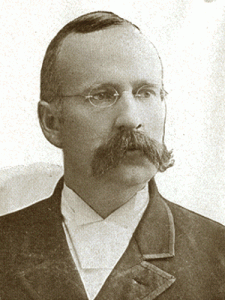
The Trial of Rudger Clawson
Charles S. Zane became chief justice of Utah in 1884. He came to the territory, August 23, of that year. He was a man whose moral life was above reproach, but he was possessed of an intolerant spirit, and was determined to conduct a strict enforcement of the Edmunds Law. The first case to be tried under that law came before his court October 15, 1884. It was the case of Rudger Clawson, who was found guilty, and when asked by the court if he had any legal cause to show why judgment should not be pronounced he replied:
“Your honor, I very much regret that the laws of my country should come in conflict with the laws of God; but whenever they do, I shall invariably choose the latter. If I did not so express myself, I should feel unworthy of the cause I represent. The constitution of the United States expressly says that Congress shall make no law respecting an establishment of religion or prohibiting the free exercise thereof. (It cannot be denied I think, that marriage, when attended and sanctioned by religious rites and ceremonies, is an establishment of religion.) The law of 1862 and the Edmunds Law were expressly designed to operate against marriage as practiced and believed in by the Latter-day Saints. They are therefore unconstitutional, and of course cannot command the respect that a constitutional law would. That is all I have to say, your honor.”
The speech was characteristic of the man. It was bold, sincere, but not defiant. It struck the judge with amazement and he determined on a heavy penalty. It was the third day of November when Elder Clawson was before the court. He was sentenced to pay a fine of eight hundred dollars and imprisonment for four years. Elder Clawson remained in prison until December 12, 1887—three years, one month and ten days—when he received a pardon from President Grover Cleveland.22
The Segregation Ruling
Following this trial there was inaugurated a cruel and determined persecution. Women were sent to prison for contempt because they would not testify against their husbands. The courts ruled that indictments might be found against a man guilty of cohabitation “for every day.” To be seen at the home of a plural wife, or to support his plural family, was sufficient to create an offense against a man. Each “distinct and separate violation of the law,” as interpreted by the judges, was a separate offense and was liable for punishment.
This order of segregation, as it was called, drove many of the leading brethren into exile, for it was virtually an announcement that the violation of the Edmunds Law could be punished by life imprisonment. Later, however, while the supreme court of the United States upheld the Edmunds Law, it condemned the action of the judges in Utah in establishing the “segregation” policy. This came in the habeas corpus case of Elder Lorenzo Snow in February, 1887. While, however, this ruling was being enforced, the First Presidency were in retirement and communicated with the Saints from time to time in general epistles.23
Sincerity of the “Mormon” People
With all the severity practiced against the “Mormon” people under the Edmunds Law, yet it did not satisfy the enemies of the Church. Without question many of the law makers had imputed to the Latter-day Saints impure motives in the practice of plural marriage. They now discovered through the prosecutions, which fell into the category of persecutions, that it was a matter of the most sincere and sacred character. Nevertheless they were determined to put an end to the practice. Heavier penalties did not seem to avail, for the members of the Church accepted plural marriage as a sacred religious rite, commanded by the Lord, and they would rather die than break their covenants. The actions of the government they looked upon as unconstitutional and an attack upon their religious duties, and while they desired to be, and were, loyal to the country, at the same time they desired to be loyal to their God.24
The Edmunds-Tucker Law
In March, 1887, Congress passed a supplemental act known as the Edmunds-Tucker Law. President Grover Cleveland neither approved nor disapproved of the act, so it became a law without his signature. Among the many features of this measure were the disincorporation of The Church of Jesus Christ of Latter-day Saints, and the dissolving of the Perpetual Emigrating Fund Company, the property of which was escheated to the government of the United States for the benefit of the common schools of Utah. Female suffrage was abolished. It was made the duty of the attorney general of the United States to proceed against the Church and wind up its affairs and the title to all property—except that “no building or grounds appurtenant thereto held and occupied exclusively for the purpose of the worship of God, or parsonage, or burial ground shall be forfeited”—be transferred and escheated to the United States.25
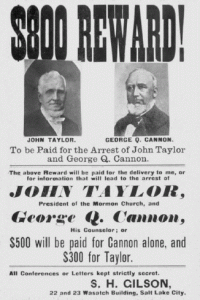
Proceedings in Escheatment
At the instance of the attorney general of the United States, suits were filed July 30, 1887, against the Church, and the Perpetual Emigrating Fund Company, and their property was confiscated. November 5, 1887, United States Marshal Dyer was appointed receiver, and took charge of the real and personal property of the Church to control it.
While this infamous measure was before Congress there were many brave men who stood up in the face of the popular clamor and almost united vindictiveness and hatred of the Church, and denounced the high-handed proceedings. Such also had been the case when previous legislation was enacted.
The government very graciously permitted the Church to occupy the tithing office and historian’s office, at a yearly rental of $2,400; and the Gardo house at $450 a month. The Temple Block was also retained by the payment of a stipulated rent. All this happened in the United States in the year 1887, not in Spain or Holland in the dark ages or the days of the Inquisition.26
Death of President John Taylor
Early in the year 1887, because of persecution, President John Taylor and his counselors were forced into exile. The trials and difficulties through which the Church was passing weighed heavily upon the venerable President. He did not live to see the final delivery of the Church property into the hands of a receiver. He died in exile July 25, 1887, at the home of Thomas F. Roueche, at Kaysville, Davis County, Utah, a martyr to the cause of truth which he espoused. At the time of his passing his counselors were with him. His life had been one of trial and suffering. He was a heroic character, strong in his convictions, just in his dealings, uncompromising with evil. It is proper here to quote the words of his counselors at the time of his death:
“President John Taylor has been killed by the cruelty of officials who have, in this territory, misrepresented the government of the United States. There is no room to doubt that if he had been permitted to enjoy the comforts of home, the ministrations of his family, the exercise to which he had been accustomed, but of which he was deprived, he might have lived for many years yet. His blood stains the clothes of men, who with insensate hate have offered rewards for his arrest and have hounded him to the grave. History will yet call their deeds by their right names” 2728
- Essentials in Church History. Joseph Fielding Smith, pg. 478
- Ibid., pg. 479
- Ibid., pg. 479
- Ibid., pg. 479-480
- Ibid., pg. 480
- Ibid., pg. 480-81
- Ibid., pg. 481-82
- Ibid., pg. 482
- Ibid., pg. 482-83
- Ibid., pg. 483
- Ibid., pg. 483
- Ibid., pg. 484
- Ibid., pg. 484
- Ibid., pg. 484-85
- Ibid., pg. 485
- Ibid., pg. 485-86
- Ibid., pg. 486
- Ibid., pg. 486
- Ibid., pg. 486-87
- Ibid., pg. 487
- Ibid., pg. 487
- Ibid., pg. 487-88
- Ibid., pg. 488
- Ibid., pg. 488-89
- Ibid., pg. 489
- Ibid., pg. 489-90
- Life of John Taylor—Roberts, p. 414
- Essentials in Church History. Joseph Fielding Smith, pg. 490


